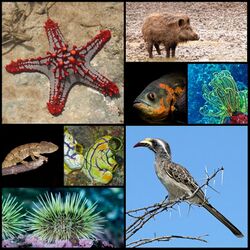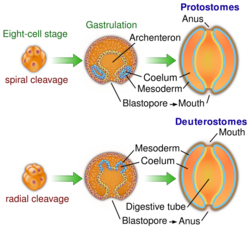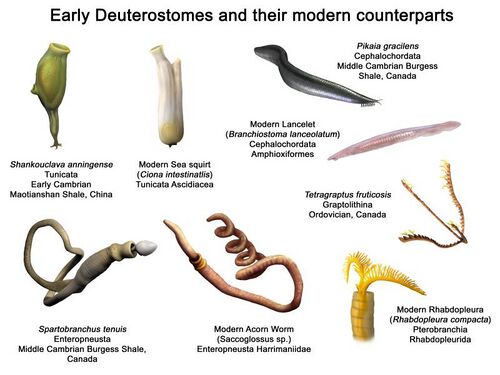Biology:Deuterostome
| Deuterostomes | |
|---|---|

| |
| Examples of deuterostomes | |
| Scientific classification | |
| Domain: | Eukaryota |
| Kingdom: | Animalia |
| Clade: | ParaHoxozoa |
| Clade: | Bilateria |
| Clade: | Nephrozoa |
| Superphylum: | Deuterostomia Grobben, 1908 |
| Clades | |
| |
Deuterostomes (from Greek: lit. second mouth) are bilaterian animals of the superphylum Deuterostomia (/ˌdjuːtərəˈstoʊmi.ə/),[2][3] typically characterized by their anus forming before the mouth during embryonic development. The three major clades of extant deuterostomes include chordates (vertebrates, lancelets, sea squirts, salps and larvaceans), echinoderms (sea stars, brittle stars, sea urchins, sea cucumbers and sea lilies) and hemichordates (acorn worms).
In deuterostomy, the developing embryo's first opening (the blastopore) becomes the anus and cloaca, while the mouth is formed at a different site later on. This was initially the group's distinguishing characteristic, but deuterostomy has since been discovered among protostomes as well.[4] This group is also known as enterocoelomates, because their coelom develops through enterocoely.
Deuterostomia's sister clade is Protostomia, animals that develop mouth first and whose digestive tract development is more varied, which include ecdysozoans (panarthropods, nematoids, penis worms, mud dragons etc.) and spiralians (mollusks, annelids, flatworms, rotifers, arrow worms, etc.) as well as the extinct Kimberella. Together with Protostomia and their outgroup Xenacoelomorpha, they constitute the large infrakingdom Bilateria, i.e. animals with bilateral symmetry and three germ layers.
Systematics
History
Initially, Deuterostomia included the phyla Brachiopoda,[5] Bryozoa,[6] Chaetognatha,[7] and Phoronida[5] based on morphological and embryological characteristics. However, Superphylum Deuterostomia was redefined in 1995 based on DNA molecular sequence analyses when the lophophorates were removed from it and combined with other protostome animals to form superphylum Lophotrochozoa.[8] The phylum Chaetognatha (arrow worms) may belong here,[7] but molecular studies have placed them in the protostomes more often.[9][10] Genetic studies have also revealed that deuterostomes have more than 30 genes not found in any other animal groups, but are present in some marine algae and prokaryotes. This could mean they are very ancient genes that were lost in other organisms, or that a common ancestor acquired them through horizontal gene transfer.[11]
While protostomes as a monophyletic group has strong support, research has shown that deuterostomes may be paraphyletic, and what was once considered traits of deuterostomes could instead be traits of the last common bilaterian ancestor. This suggests the deuterostome branch is very short or non-existent. The Xenambulacraria's sister group could be both the chordates or the protostomes, or be equally distantly related to them both.[12]
Classification
These are the following phyla/subgroups of the deuterostomes:
- Superphylum Deuterostomia
- Phylum Chordata
- Subphylum Cephalochordata (lancelets and relatives)
- Clade Olfactores
- Subphylum Tunicata (tunicates)
- Subphylum Vertebrata
- Superclass Agnatha (jawless fish)
- Infraphylum Gnathostomata (jawed fish)
- Class Chondrichthyes (cartilaginous fish)
- Superclass Osteichthyes (bony fish - includes tetrapods)
- Clade Ambulacraria
- Phylum Hemichordata
- Class Planctosphaeroidea
- Class Enteropneusta (acorn worms)
- Class Pterobranchia
- Phylum Echinodermata
- Subphylum Asterozoa
- Class Asteroidea (starfish)
- Class Ophiuroidea (brittle stars)
- Subphylum Crinozoa (sea lillies and relatives)
- Subphylum Echinozoa
- Echinoidea (sea urchins)
- Holothuriodea (sea cucumbers)
- Subphylum Asterozoa
- Phylum Hemichordata
- Phylum Chordata
There is a possibility that Ambulacraria is the sister clade to Xenacoelomorpha, and could form the Xenambulacraria group.[13][14][15]
Notable characteristics

In both deuterostomes and protostomes, a zygote first develops into a hollow ball of cells, called a blastula. In deuterostomes, the early divisions occur parallel or perpendicular to the polar axis. This is called radial cleavage, and also occurs in certain protostomes, such as the lophophorates.
Most deuterostomes display indeterminate cleavage, in which the developmental fate of the cells in the developing embryo is not determined by the identity of the parent cell. Thus, if the first four cells are separated, each can develop into a complete small larva; and if a cell is removed from the blastula, the other cells will compensate.
In deuterostomes the mesoderm forms as evaginations of the developed gut that pinch off to form the coelom. This process is called enterocoely.
Another feature present in both the Hemichordata and Chordata is pharyngotremy; the presence of spiracles or gill slits into the pharynx, which is also found in some primitive fossil echinoderms (mitrates).[16][17] A hollow nerve cord is found in all chordates, including tunicates (in the larval stage). Some hemichordates also have a tubular nerve cord. In the early embryonic stage, it looks like the hollow nerve cord of chordates.
Except for the echinoderms, both the hemichordates and the chordates have a thickening of the aorta, homologous to the chordate heart, which contracts to pump blood. This suggests a presence in the deuterostome ancestor of the three groups, with the echinoderms having secondarily lost it.[citation needed]
The highly modified nervous system of echinoderms obscures much about their ancestry, but several facts suggest that all present deuterostomes evolved from a common ancestor that had pharyngeal gill slits, a hollow nerve cord, circular and longitudinal muscles and a segmented body.[18]
Formation of mouth and anus
The defining characteristic of the deuterostome is the fact that the blastopore (the opening at the bottom of the forming gastrula) becomes the anus, whereas in protostomes the blastopore becomes the mouth. The deuterostome mouth develops at the opposite end of the embryo, from the blastopore, and a digestive tract develops in the middle, connecting the two.
In many animals, these early development stages later evolved in ways that no longer reflect these original patterns. For instance, humans have already formed a gut tube at the time of formation of the mouth and anus. Then the mouth forms first[citation needed], during the fourth week of development, and the anus forms four weeks later, temporarily forming a cloaca.
Origins and evolution
The majority of animals more complex than jellyfish and other Cnidarians are split into two groups, the protostomes and deuterostomes. Chordates (which include all the vertebrates) are deuterostomes.[19] It seems likely that the 555 million year old Kimberella was a member of the protostomes.[20][21] That implies that the protostome and deuterostome lineages split some time before Kimberella appeared — at least 558 million years ago, and hence well before the start of the Cambrian 541 million years ago,[19] i.e. during the later part of the Ediacaran Period (circa 635-539 Mya, around the end of global Marinoan glaciation in the late Neoproterozoic). It has been proposed that the ancestral deuterostome, before the chordate/ambulacrarian split, could have been a chordate-like animal with a terminal anus and pharyngeal openings but no gill slits, with active suspension feeding strategy.[22]
The last common ancestor of the deuterostomes had lost all innexin diversity.[23]
Fossils of one major deuterostome group, the echinoderms (whose modern members include sea stars, sea urchins and crinoids), are quite common from the start of Series 2 of the Cambrian, 521 million years ago.[24] The Mid Cambrian fossil Rhabdotubus johanssoni has been interpreted as a pterobranch hemichordate.[25] Opinions differ about whether the Chengjiang fauna fossil Yunnanozoon, from the earlier Cambrian, was a hemichordate or chordate.[26][27] Another Chengjiang fossil, Haikouella lanceolata, is interpreted as a chordate and possibly a craniate, as it shows signs of a heart, arteries, gill filaments, a tail, a neural chord with a brain at the front end, and possibly eyes — although it also had short tentacles round its mouth.[27] Haikouichthys and Myllokunmingia, also from the Chengjiang fauna, are regarded as fish.[28][29] Pikaia, discovered much earlier but from the Mid Cambrian Burgess Shale, is also regarded as a primitive chordate.[30]
On the other hand, fossils of early chordates are very rare, as non-vertebrate chordates have no bone tissue or teeth, and fossils of no Post-Cambrian non-vertebrate chordates are known aside from the Permian-aged Paleobranchiostoma, trace fossils of the Ordovician colonial tunicate Catellocaula, and various Jurassic-aged and Tertiary-aged spicules tentatively attributed to ascidians.
Phylogeny
Below is a phylogenetic tree showing consensus relationships among deuterostome taxa. Phylogenomic evidence suggests the enteropneust family, Torquaratoridae, fall within the Ptychoderidae. The tree is based on 16S +18S rRNA sequence data and phylogenomic studies from multiple sources.[31][12] The approximate dates for each radiation into a new clade are given in millions of years ago (Mya). Not all dates are consistent, as of date ranges only the center is given.[32]
| Deuterostomia |
| ||||||||||||||||||||||||||||||||||||||||||||||||||||||||||||||||||||||||||||||||||||||||||||||||||||||||||||||||||
| Protostomia |
| ||||||||||||||||||||||||||||||||||||||||||||||||||||||||||||||||||||||||||||||||||||||||||||||||||||||||||||||||||
| 550 mya |
Support for the clade Deuterostomia is not unequivocal. In particular, the Ambulacraria appear to be related to the Xenacoelomorpha. If upheld, this raises two possibilities: either the Ambulacraria are taken out of the deuterostome-protostome dichotomy (in which case the grouping Deuterostomia dissolves, with Chordata and Protostomia grouped together as Centroneuralia), or the Xenacoelomorpha are re-positioned next to Ambulacraria within the Deuterostomia as in the above diagram.[12][33][34][35][36][37][38][39]
See also
- Biology:Timeline of the evolutionary history of life – Major events during the development of life
- Urbilaterian, a hypothethical common ancestor to Protostomes and Deuterostomes
References
- ↑ Han, Jian; Morris, Simon Conway; Ou, Qiang; Shu, Degan; Huang, Hai (2017). "Meiofaunal deuterostomes from the basal Cambrian of Shaanxi (China)". Nature 542 (7640): 228–231. doi:10.1038/nature21072. PMID 28135722. Bibcode: 2017Natur.542..228H.
- ↑ Wade, Nicholas (30 January 2017). "This Prehistoric Human Ancestor Was All Mouth". The New York Times. https://www.nytimes.com/2017/01/30/science/this-prehistoric-human-ancestor-was-all-mouth.html.
- ↑ Han, Jian; Morris, Simon Conway; Ou, Qiang; Shu, Degan; Huang, Hai (2017). "Meiofaunal deuterostomes from the basal Cambrian of Shaanxi (China)". Nature 542 (7640): 228–231. doi:10.1038/nature21072. ISSN 0028-0836. PMID 28135722. Bibcode: 2017Natur.542..228H.
- ↑ Martín-Durán, José M.; Passamaneck, Yale J.; Martindale, Mark Q.; Hejnol, Andreas (2016). "The developmental basis for the recurrent evolution of deuterostomy and protostomy". Nature Ecology & Evolution 1 (1): 0005. doi:10.1038/s41559-016-0005. PMID 28812551. https://qmro.qmul.ac.uk/xmlui/handle/123456789/54816.
- ↑ 5.0 5.1 Eernisse, Douglas J.; Albert, James S.; Anderson, Frank E. (1992-09-01). "Annelida and Arthropoda are Not Sister Taxa: A Phylogenetic Analysis of Spiralian Metazoan Morphology" (in en). Systematic Biology 41 (3): 305–330. doi:10.1093/sysbio/41.3.305. ISSN 1063-5157. https://academic.oup.com/sysbio/article/41/3/305/1676076.
- ↑ Nielsen, C. (July 2002). "The Phylogenetic Position of Entoprocta, Ectoprocta, Phoronida, and Brachiopoda". Integrative and Comparative Biology 42 (3): 685–691. doi:10.1093/icb/42.3.685. PMID 21708765.
- ↑ 7.0 7.1 Brusca, R.C.; Brusca, G.J. (1990). Invertebrates. Sinauer Associates. p. 669. https://archive.org/details/invertebrates0000brus.
- ↑ Halanych, K.M.; Bacheller, J.; Liva, S.; Aguinaldo, A. A.; Hillis, D.M.; Lake, J.A. (17 March 1995). "18S rDNA evidence that the Lophophorates are Protostome Animals". Science 267 (5204): 1641–1643. doi:10.1126/science.7886451. PMID 7886451. Bibcode: 1995Sci...267.1641H.
- ↑ Marlétaz, Ferdinand; Martin, Elise; Perez, Yvan; Papillon, Daniel; Caubit, Xavier; Lowe, Christopher J.; Freeman, Bob; Fasano, Laurent et al. (2006-08-01). "Chaetognath phylogenomics: a protostome with deuterostome-like development" (in en). Current Biology 16 (15): R577–R578. doi:10.1016/j.cub.2006.07.016. PMID 16890510.
- ↑ Marlétaz, Ferdinand; Peijnenburg, Katja T.C.A.; Goto, Taichiro; Satoh, Noriyuki; Rokhsar, Daniel S. (2019-01-21). "A New Spiralian Phylogeny Places the Enigmatic Arrow Worms among Gnathiferans" (in en). Current Biology 29 (2): 312–318.e3. doi:10.1016/j.cub.2018.11.042. PMID 30639106.
- ↑ Acorn worm genome reveals gill origins of human pharynx | Berkeley News
- ↑ 12.0 12.1 12.2 Kapli, Paschalia; Natsidis, Paschalis; Leite, Daniel J.; Fursman, Maximilian; Jeffrie, Nadia; Rahman, Imran A.; Philippe, Hervé; Copley, Richard R. et al. (March 1, 2021). "Lack of support for Deuterostomia prompts reinterpretation of the first Bilateria". Science Advances 7 (12): eabe2741. doi:10.1126/sciadv.abe2741. PMID 33741592. Bibcode: 2021SciA....7.2741K.
- ↑ Bourlat, Sarah J.; Juliusdottir, Thorhildur; Lowe, Christopher J.; Freeman, Robert; Aronowicz, Jochanan; Kirschner, Mark; Lander, Eric S.; Thorndyke, Michael et al. (2006). "Deuterostome phylogeny reveals monophyletic chordates and the new phylum Xenoturbellida". Nature 444 (7115): 85–88. doi:10.1038/nature05241. ISSN 0028-0836. PMID 17051155. Bibcode: 2006Natur.444...85B.
- ↑ Philippe, Hervé; Poustka, Albert J.; Chiodin, Marta; Hoff, Katharina J.; Dessimoz, Christophe; Tomiczek, Bartlomiej; Schiffer, Philipp H.; Müller, Steven et al. (2019). "Mitigating Anticipated Effects of Systematic Errors Supports Sister-Group Relationship between Xenacoelomorpha and Ambulacraria". Current Biology 29 (11): 1818–1826.e6. doi:10.1016/j.cub.2019.04.009. ISSN 0960-9822. PMID 31104936.
- ↑ Marlétaz, Ferdinand (2019-06-17). "Zoology: Worming into the Origin of Bilaterians" (in en). Current Biology 29 (12): R577–R579. doi:10.1016/j.cub.2019.05.006. ISSN 0960-9822. PMID 31211978.
- ↑ Graham, A; Richardson, J (2012). "Developmental and evolutionary origins of the pharyngeal apparatus". Evodevo 3 (1): 24. doi:10.1186/2041-9139-3-24. PMID 23020903.
- ↑ Valentine, James W. (June 18, 2004). On the Origin of Phyla. University of Chicago Press. ISBN 978-0-226-84548-7. https://books.google.com/books?id=DMBkmHm5fe4C&q=pharyngotremy%E2%80%94+the+presence+of+spiracles+or+gill+slits&pg=PA382.
- ↑ Smith, Andrew B. (2012). "Cambrian problematica and the diversification of deuterostomes". BMC Biology 10 (79): 79. doi:10.1186/1741-7007-10-79. PMID 23031503.
- ↑ 19.0 19.1 Erwin, Douglas H.; Eric H. Davidson (1 July 2002). "The last common bilaterian ancestor". Development 129 (13): 3021–3032. doi:10.1242/dev.129.13.3021. PMID 12070079. http://dev.biologists.org/cgi/content/full/129/13/3021.
- ↑ {{{1}}} (2007), "{{{2}}}", in Vickers-Rich, Patricia; Komarower, Patricia, The Rise and Fall of the Ediacaran Biota, Special publications, 286, London: Geological Society, pp. {{{3}}}–{{{4}}}, doi:10.1144/SP286.{{{5}}}, ISBN 9781862392335, OCLC 156823511
- ↑ Butterfield, N.J. (December 2006). "Hooking some stem-group "worms": fossil lophotrochozoans in the Burgess Shale". BioEssays 28 (12): 1161–1166. doi:10.1002/bies.20507. PMID 17120226.
- ↑ Li, Yujing; Dunn, Frances S.; Murdock, Duncan J.E.; Guo, Jin; Rahman, Imran A.; Cong, Peiyun (May 10, 2023). "Cambrian stem-group ambulacrarians and the nature of the ancestral deuterostome". Current Biology 33 (12): 2359–2366.e2. doi:10.1016/j.cub.2023.04.048. PMID 37167976.
- ↑ Connexins evolved after early chordates lost innexin diversity
- ↑ Bengtson, S. (2004). "Early Skeletal Fossils in Neoproterozoic–Cambrian Biological Revolutions". Paleontological Society Papers 10: 67–78. doi:10.1017/S1089332600002345. http://www.nrm.se/download/18.4e32c81078a8d9249800021554/Bengtson2004ESF.pdf.
- ↑ Bengtson, S.; Urbanek, A. (October 2007). "Rhabdotubus, a Middle Cambrian rhabdopleurid hemichordate". Lethaia 19 (4): 293–308. doi:10.1111/j.1502-3931.1986.tb00743.x.
- ↑ Shu, D.; Zhang, X.; Chen, L. (April 1996). "Reinterpretation of Yunnanozoon as the earliest known hemichordate". Nature 380 (6573): 428–430. doi:10.1038/380428a0. Bibcode: 1996Natur.380..428S.
- ↑ 27.0 27.1 Chen, J-Y.; Hang, D-Y.; Li, C.W. (December 1999). "An early Cambrian craniate-like chordate". Nature 402 (6761): 518–522. doi:10.1038/990080. Bibcode: 1999Natur.402..518C.
- ↑ Shu, D.-G. et al. (January 2003). "Head and backbone of the Early Cambrian vertebrate Haikouichthys". Nature 421 (6922): 526–529. doi:10.1038/nature01264. PMID 12556891. Bibcode: 2003Natur.421..526S.
- ↑ Shu, D.-G.; Conway Morris, S.; Zhang, X.-L. (November 1999). "Lower Cambrian vertebrates from south China". Nature 402 (6757): 42–46. doi:10.1038/46965. Bibcode: 1999Natur.402...42S.
- ↑ Shu, D.-G.; Conway Morris, S.; Zhang, X.-L. (November 1996). "A Pikaia-like chordate from the Lower Cambrian of China". Nature 384 (6605): 157–158. doi:10.1038/384157a0. Bibcode: 1996Natur.384..157S.
- ↑ Tassia, Michael G.; Cannon, Johanna T.; Konikoff, Charlotte E.; Shenkar, Noa; Halanych, Kenneth M.; Swalla, Billie J. (2016-10-04). "The Global Diversity of Hemichordata". PLOS ONE 11 (10): e0162564. doi:10.1371/journal.pone.0162564. PMID 27701429. Bibcode: 2016PLoSO..1162564T.
- ↑ Han, Jian; Morris, Simon Conway; Ou, Qian; Shu, Degan; Huang, Hai (2017). "Meiofaunal deuterostomes from the basal Cambrian of Shaanxi (China)". Nature 542 (7640): 228–231. doi:10.1038/nature21072. PMID 28135722. Bibcode: 2017Natur.542..228H.
- ↑ Philippe, Hervé; Poustka, Albert J.; Chiodin, Marta; Hoff, Katharina J.; Dessimoz, Christophe; Tomiczek, Bartlomiej; Schiffer, Philipp H.; Müller, Steven et al. (2019-06-03). "Mitigating Anticipated Effects of Systematic Errors Supports Sister-Group Relationship between Xenacoelomorpha and Ambulacraria" (in en). Current Biology 29 (11): 1818–1826.e6. doi:10.1016/j.cub.2019.04.009. ISSN 0960-9822. PMID 31104936.
- ↑ Robertson, Helen E.; Lapraz, François; Egger, Bernhard; Telford, Maximilian J.; Schiffer, Philipp H. (2017-05-12). "The mitochondrial genomes of the acoelomorph worms Paratomella rubra, Isodiametra pulchra and Archaphanostoma ylvae" (in en). Scientific Reports 7 (1): 1847. doi:10.1038/s41598-017-01608-4. ISSN 2045-2322. PMID 28500313. Bibcode: 2017NatSR...7.1847R.
- ↑ Philippe, Hervé; Brinkmann, Henner; Copley, Richard R.; Moroz, Leonid L.; Nakano, Hiroaki; Poustka, Albert J.; Wallberg, Andreas; Peterson, Kevin J. et al. (2011-02-10). "Acoelomorph flatworms are deuterostomes related to Xenoturbella" (in en). Nature 470 (7333): 255–258. doi:10.1038/nature09676. ISSN 0028-0836. PMID 21307940. Bibcode: 2011Natur.470..255P.
- ↑ Edgecombe, Gregory D.; Giribet, Gonzalo; Dunn, Casey W.; Hejnol, Andreas; Kristensen, Reinhardt M.; Neves, Ricardo C.; Rouse, Greg W.; Worsaae, Katrine et al. (June 2011). "Higher-level metazoan relationships: recent progress and remaining questions". Organisms, Diversity & Evolution 11 (2): 151–172. doi:10.1007/s13127-011-0044-4. http://nrs.harvard.edu/urn-3:HUL.InstRepos:27755241.
- ↑ Rouse, Greg W.; Wilson, Nerida G.; Carvajal, Jose I.; Vriejenhoek, Robert C. (4 February 2016). "New deep-sea species of Xenoturbella and the position of Xenacoelomorpha". Nature 530 (2): 94–97. doi:10.1038/nature16545. PMID 26842060. Bibcode: 2016Natur.530...94R. https://www.nature.com/articles/nature16545.
- ↑ Cannon, Johanna Taylor; Vellutini, Bruno Cossermelli; Smith III, Julian; Ronquist, Frederik; Jondelius, Ulf; Hejnol, Andreas (4 February 2016). "Xenacoelomorpha is the sister group to Nephrozoa". Nature 530 (2): 89–93. doi:10.1038/nature16520. PMID 26842059. Bibcode: 2016Natur.530...89C. https://www.nature.com/articles/nature16520.
- ↑ Paschalia Kapli; Maximilian J. Telford (11 December 2020). "Topology-dependent asymmetry in systematic errors affects phylogenetic placement of Ctenophora and Xenacoelomorpha". Science Advances 6 (50): eabc5162. doi:10.1126/sciadv.abc5162. PMID 33310849. Bibcode: 2020SciA....6.5162K.
Further reading
- Swalla, B. J.; Smith, A. B. (2008). "Deciphering deuterostome phylogeny: Molecular, morphological and palaeontological perspectives". Philosophical Transactions of the Royal Society of London. Series B, Biological Sciences 363 (1496): 1557–1568. doi:10.1098/rstb.2007.2246. PMID 18192178.
External links
Wikidata ☰ Q150866 entry
 |





